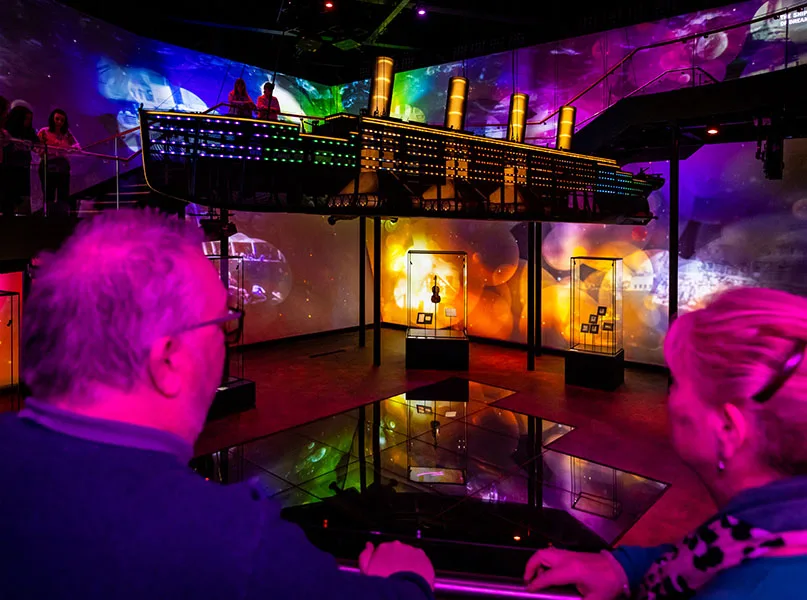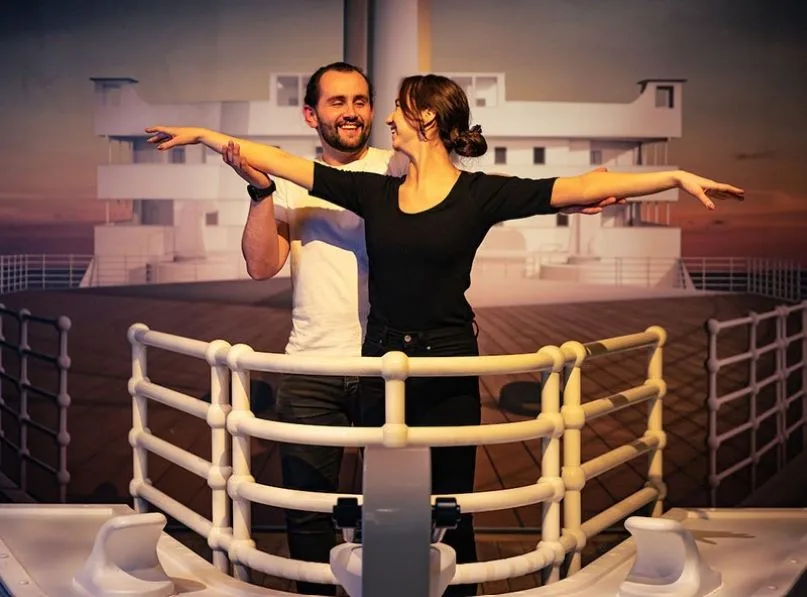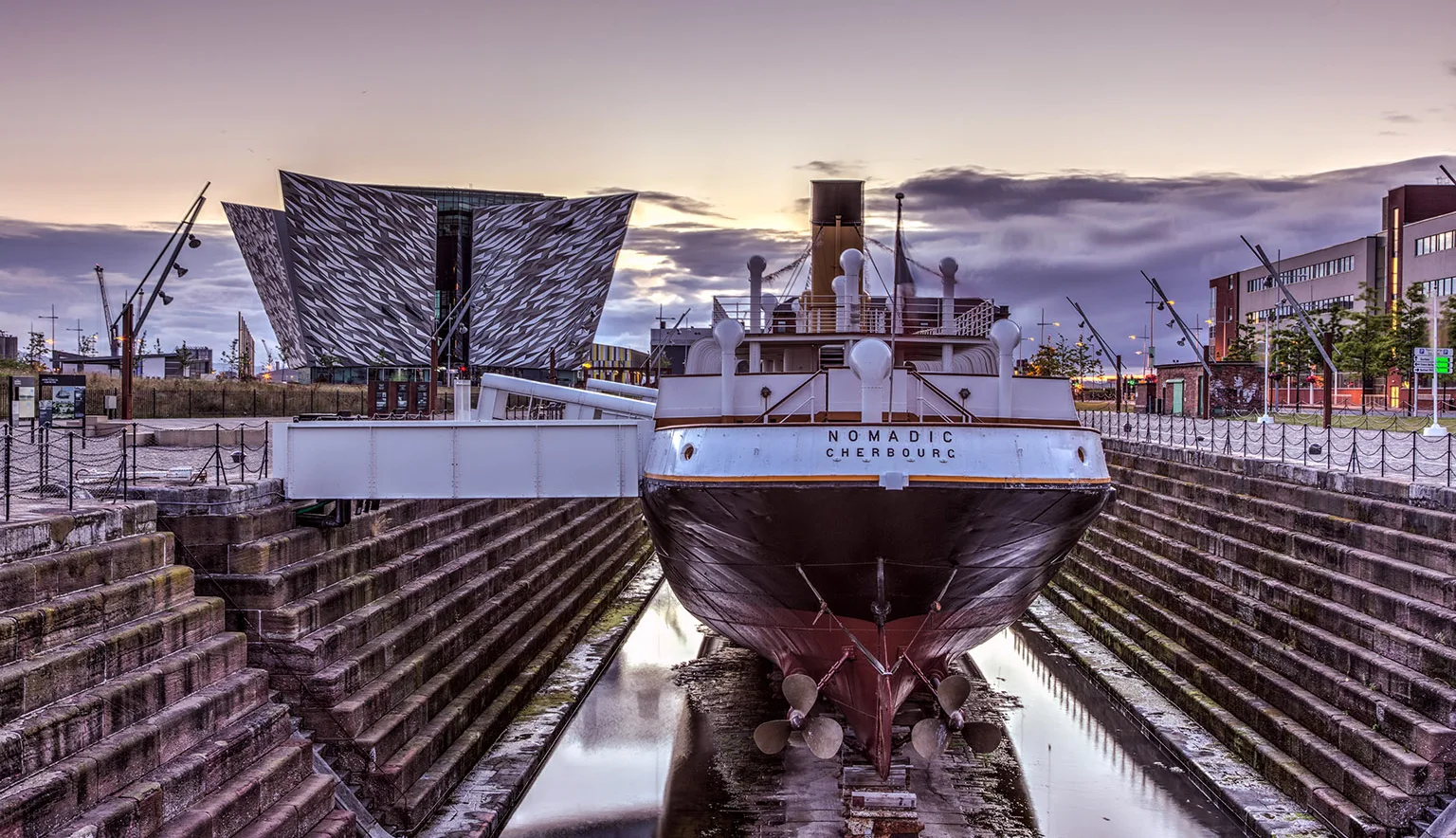Over a century on from one of the most infamous shipwrecks in history, Titanic Belfast has become a major tourist attraction in Northern Ireland. We set sail and immerse ourselves in the world’s largest Titanic visitor experience with Chief Executive, Judith Owens MBE.
TITANIC BELFAST
Titanic was the largest and most luxurious ship of its time.
Launched in 1911 at the Harland & Wolff shipyard in Belfast, Northern Ireland, many believed the vessel was unsinkable thanks to its 16 watertight compartments, which were designed to keep it afloat if damaged.
However, on 15th April 1912, Titanic infamously sunk only four days into its maiden voyage from Southampton, England to New York, US after striking an iceberg in the North Atlantic Ocean, sadly taking the lives of around 1,500 passengers and crew members that were onboard.
Titanic has captured the imagination for over a century and played a prominent role in popular culture, with the deadly disaster inspiring numerous books, plays, films, songs, poems, and works of art.
It also quickly became a catalyst for change, leading to new ship designs, safety regulations, maritime laws, international treaties, and more.
Marking 100 years since the disaster, Titanic Belfast opened on 31st March 2012 and sits at the top of the historic slipways where the vessel was built and launched.
As a world-leading tourist attraction, Titanic Belfast celebrates the maritime heritage and industrial past of the Northern Irish capital.
“Belfast is truly the most authentic place to discover the story of this world-famous ship – it was Titanic’s home, and still is,” opens Chief Executive, Judith Owens MBE.
“Telling its authentic story is the only way to properly celebrate the hard work and ambition of those who designed and built the ship and to respectfully pay tribute to her passengers and crew.”

EMOTIVE EXPERIENCE
Titanic Belfast was a game-changer for Northern Ireland, which was emerging from years of conflict, as it delivered a step-change in tourism for the country.
A signature project that came out of the Good Friday Agreement, there is no doubt that Titanic Belfast has played a key role in the resurgence of tourism since opening in 2012, not only for Belfast and Northern Ireland but the island of Ireland as a whole.
Many multi-generational families and groups visit Titanic Belfast, from young children learning about the ship in school for the first time to their grandparents who perhaps had links to the shipyard.
To date, it has welcomed more than eight million visitors from over 145 different countries, changing the tourism footprint of Northern Ireland and opening the destination to international visitors.
“It has proven to be a shining example of how a significant tourism investment, combined with passion and belief, can be a catalyst for economic growth and help positively position a destination on the worldwide stage,” Owens enthuses.
“Only here in Belfast can you experience the authentic maritime heritage of the area in which Titanic was designed, built, and launched.”
Indeed, the Titanic Experience delivers an enriched and emotive journey, offering the authentic Titanic story alongside an original maritime heritage collection, with artefacts including Wallace Hartley’s violin, launch day tickets, the last lunch menu enjoyed by first-class passengers, a lifejacket and deck chair from the ship, and many other fascinating items of cultural and historical interest.
The self-guided experience, which extends over nine interactive galleries, tells the story of Titanic from conception through to her construction, launch, famous maiden voyage, and tragic end, allowing you to explore the shipyard, walk the decks and historic slipways, and travel to the depths of the ocean.
Visitors can also step onboard SS Nomadic, the tender to Titanic and the last remaining White Star Line vessel in the world.
“Titanic Belfast is committed to celebrating the city’s maritime heritage and the people who built Titanic, whilst commemorating those who lost their lives during the tragic sinking,” outlines Owens.
“We work hard to ensure that we are sympathetic towards the story, show respect of those who have family ties with Titanic, and ensure our building and the surrounding area remain a place where those lost at sea can be remembered respectfully.”

“Only here in Belfast can you experience the authentic maritime heritage of the area in which Titanic was designed, built, and launched”
Judith Owens MBE, Chief Executive, Titanic Belfast
IMMERSIVE TECHNOLOGY
The Titanic Experience combines this authenticity and heritage with immersive technology to bring the story of the vessel to life.
Just like the designers who created the ship, Titanic Belfast continually innovates how it tells her story and finds ways to capture the imagination.
“Dreaming big, exploring new ways to overcome challenges, and then doing what has never been done before is in Titanic’s DNA,” Owens tells us.
“However, I believe that innovation isn’t always about doing the newest thing or using the latest technology. For me, it’s about using existing technology in a way that hasn’t been done before.”
For example, during a recent £4.7 million refurbishment undertaken to reimagine the latter part of the Titanic Experience, projectors had to be hidden in artefact cases so they wouldn’t be seen by guests.
Titanic Belfast also had to create a bespoke shock absorber system so that the projectors would not shake as visitors descended the stairs.
“It’s the little innovations that lead to an immersive guest experience,” she adds.
At the time the business was planning its refresh project, virtual reality (VR) was the new technology everyone was looking at utilising in attractions.
However, VR didn’t necessarily create the immersive and emotional connections that Titanic Belfast wanted for guests, whilst also allowing it to deliver the high-capacity daily visitor numbers it needed to maintain in the busy summer season.
“You could say we disrupt the norm as we don’t always follow industry trends or what others are doing. Instead, we look at what’s right for us, our experience, and what guests want,” notes Owens.

WORLD-CLASS SPECTACLE
The Titanic Experience reopened in March 2023 following the refurbishment, which saw three of its existing galleries transformed into four themed spaces that shed new light on Titanic’s story.
A new theme, ‘The Pursuit of Dreams’, was also introduced, along with a stunning new artefact collection and an illuminated 7.6-metre-long scale model of Titanic, which rotates in sync with state-of-the-art projections.
It additionally showcases never-before-heard stories of the hopes and dreams of passengers, a collection of artefacts being displayed in Northern Ireland for the first time, and a musical score that beautifully encapsulates the stories and emotions throughout.
“This was Titanic Belfast’s biggest single investment and most ambitious project since opening in 2012,” acclaims Owens.
“The aim was to deliver a world-class spectacle by combining innovative technology with the authentic and emotive stories from Titanic. It will ensure we continue to drive visitors to Belfast and Northern Ireland, push boundaries, and stay at the forefront of the industry.”
Next year marks the 40th anniversary of the ship’s discovery by Dr Robert Ballard, a significant milestone in the Titanic story and one that was included in the new spaces of the reimagined Titanic Experience.
Ballard’s Quest explores the incredible top-secret US Navy mission that the renowned oceanographer undertook to locate the wreck 73 years after it sank, where his inspiration came from, and the challenges and solutions of covering such a large area in a short space of time.
Following the refresh, Titanic Belfast won the THEA Award for Outstanding Achievement – Visitor Experience Re-envisioned: Limited Budget in Hollywood from the Themed Entertainment Association (TEA), which represents the world’s leading creators, developers, designers, and producers of compelling places and experiences from around the world.

ENGAGED WORKFORCE
As well as innovating and renovating the Titanic Experience, a substantial digital transformation is currently underway at Titanic Belfast as it continually adapts behind the scenes.
“This will improve the customer experience when interacting with us in a digital environment, increase efficiency in our processes, and foster a continued sense of innovation across our team,” Owens highlights.
Titanic Belfast likewise fosters a culture of learning, development, collaboration, and inclusivity to ensure its 375 members of staff feel they are valued and have a voice.
The Great Place to Work accreditation that Titanic Belfast was certified with earlier this year is a measure of this excellent workplace culture, and a testament to the value it places on feedback to ensure employees are happy.
“We also recognise the importance of having a work-life balance, create a culture that supports both career development and personal well-being, and have developed various initiatives to support retention and grow a culture of purpose amongst staff,” expands Owens.
“As an employer, Titanic Belfast is committed to creating an engaged workforce. We support career development, strive to promote from within, and provide great employee benefits.
“It is fantastic that our teams recognise this as, from day one, they have played an important part of our success and are central to the 5-star visitor experience we provide for our guests from around the world,” she continues.
“We believe that Titanic’s truth needs a guardian. Telling the authentic story is the only way to properly celebrate the hard work and ambition of those who designed and built the ship and respectfully pay tribute to her passengers and crew”
Judith Owens MBE, Chief Executive, Titanic Belfast

PASSION FOR ACCESSIBILITY
Accessibility and inclusion, meanwhile, have always been personal passions of Owens, who has been fortunate to work with many disability organisations over the past 20 years.
Titanic Belfast continuously works to lead the way in creating an accessible and inclusive visitor attraction for all.
“We want to make sure that when visitors with additional needs plan a trip, they have the same opportunities as everyone else to enjoy their time making memories with family, friends, and loved ones,” assures Owens.
“From the original construction of our architecturally unique building right through to the recent refreshment of the Titanic Experience, accessibility and inclusion have been key considerations.”
Indeed, all general access and circulation spaces inside and outside Titanic Belfast are accessible, with lowered counters and hearing loops on ticketing desks, varied lighting levels, stairs, lifts, escalators, and accessible toilets throughout.
Significant contributions are also made on an ongoing basis by Titanic Belfast as part of its diversity and inclusion strategy, having invested £200,000 in the last year to introduce a Changing Places facility for those with more complex needs and new British Sign Language and audio-described multi-media guides, which are available in numerous languages.
“We also strive to reflect diverse perspectives in our storytelling, ensuring it resonates with a broad, international audience,” Owens emphasises.
Titanic Belfast additionally offers free carer tickets to any paying guest that requires essential assistance to visit, as well as aids such as sensory guides, wristbands, ear defenders, and blackout tents for those with autism spectrum disorder (ASD).
“We are really proud to be recognised across the tourism industry as a leader in accessibility standards, but are always continually working to further develop this and ensure our visitors’ access requirements are not only met, but exceeded.”
It also has a long-standing partnership with Orchardville, a charity that supports young people with additional needs to help upskill them for the workplace and find continued employment.
Through this initiative, Titanic Belfast has recruited several staff members who work as part of its team on an ongoing basis.
“For us, inclusion is not just about making Titanic Belfast accessible for our guests, but for our staff too,” Owens acknowledges.

POSITIVE IMPACT
Titanic Belfast evidently understands the importance of having a lasting and positive impact on the people and area in which it operates.
For example, 45p of every adult ticket purchased is allocated to a dedicated Titanic Belfast Community Impact Fund, which supports various initiatives and makes the attraction accessible to those who may face financial or social barriers.
“We are very proud of the work we are doing through the fund. In its inaugural year, it supported varied outreach activities including sponsorship of Co-Operation Ireland’s Future Leaders Programme, a school transport bursary providing free buses for 15 school visits from deprived areas, and a significant contribution to the heritage restoration of SS Nomadic.”
Donations have also been made to ‘Changing the Menu. For Good’, a project supporting homelessness and food poverty outreach in Belfast.
Additionally, Titanic Belfast is in the final stages of the Bronze Diversity Mark accreditation, which is awarded to organisations who show a commitment to addressing gender diversity, and has sponsored Business in the Community’s Climate Action Programme, which aims to actively engage and educate businesses, inspiring them to take proactive steps towards climate action.
“Through this innovative initiative, four of our suppliers were supported in completing Carbon Literacy training, certified by the Carbon Literacy Trust,” Owens informs us.
SAILING AHEAD
The tourism and hospitality sectors are ever-changing, and adaptability has been key to Titanic Belfast’s continued success.
“Sometimes, this means leading through challenges – from economic uncertainties to global events like the COVID-19 pandemic – which have underscored the importance of resilience,” Owens affirms.
“Fostering a mindset of continuous improvement and innovation has allowed us to balance short-term agility with long-term stability, ensuring Titanic Belfast continues to thrive.”
As a significant driver for Northern Ireland’s tourism industry, Titanic Belfast understands the importance of increasing visitation from across local, national, and international markets to ensure it is welcoming both first-time and returning guests.
“2025 is an opportunity for those who have not yet visited Titanic Belfast to come and discover her full story from design to discovery,” Owens concludes.

How are you driving female leadership forwards at Titanic Belfast?
Judith Owens MBE, Chief Executive: “Empowering women in leadership roles has been a deliberate part of my leadership strategy at Titanic Belfast as I believe that diverse perspectives, particularly gender diversity, lead to more innovative and resilient organisations.
“Across the business, we are committed to developing future leaders from within, ensuring our staff have access to the tools and support they need to grow into senior roles, including mentorship programmes, targeted training, and personal development plans. We’ve empowered women to pursue leadership roles without sacrificing other aspects of their lives.
“By ensuring women are represented at the highest levels of our leadership team, we’ve sent a clear message that gender is not a barrier to success. This has created a sense of aspiration and empowerment amongst other women in the organisation, inspiring them to pursue their own leadership paths.
“Additionally, having a female-led leadership team has enhanced our reputation, demonstrating our commitment to equality and making us a more attractive employer for top talent.”






















